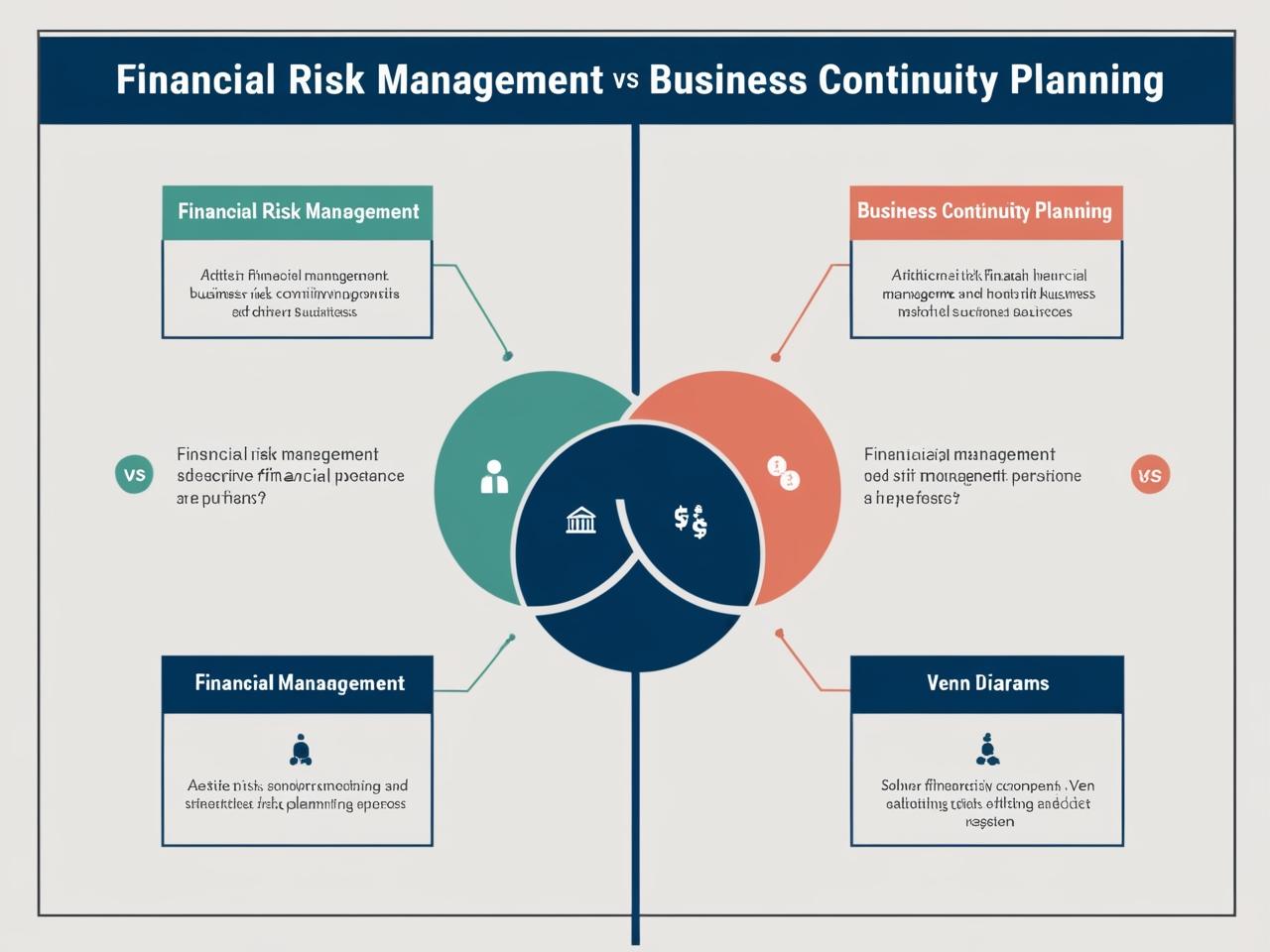In today’s volatile and fast-paced business environment, organizations must prepare for a wide range of potential disruptions and financial challenges. Two critical components of a resilient organizational strategy are
Financial risk management (FRM) and Business Continuity Planning (BCP). Although both are essential for long-term success, they serve different purposes and focus on distinct areas of risk mitigation. In this blog, we compare FRM and BCP, explain their key differences, and illustrate how they complement each other to create a robust framework for overall business stability.
Financial risk management is the process of identifying, analyzing, and mitigating risks that can negatively impact a company’s financial health. These risks may arise from market fluctuations, credit exposures, liquidity challenges, and operational inefficiencies.
Risk Identification:
The primary goal of FRM is to identify potential financial risks that could lead to losses, such as market volatility, credit defaults, and liquidity constraints.
Risk Assessment:
After identifying risks, the next step is to evaluate their likelihood and potential impact on the business. This assessment enables companies to prioritize which risks need immediate attention.
Risk Mitigation:
Businesses implement strategies such as diversification, hedging, and improved internal controls to minimize the potential adverse effects of these risks.
Continuous Monitoring:
An effective FRM framework includes continuous monitoring and periodic reviews to ensure that risk management strategies remain relevant as market conditions evolve.
Tools and Techniques in FRM
Hedging Instruments:
Financial derivatives like options, futures, and swaps are used to hedge against market risks.
Diversification:
Spreading investments across various asset classes helps reduce the impact of a downturn in any single market.
Scenario Analysis and Stress Testing:
These methods assess the potential impact of different risk scenarios on the company’s financial position, guiding strategic decisions.
Understanding Business Continuity Planning (BCP)
Business Continuity Planning is a proactive approach to ensuring that critical business functions continue during and after a disaster or unexpected disruption. BCP focuses on maintaining essential operations, protecting employees, and minimizing downtime.
Objectives of Business Continuity Planning
Maintaining Operational Resilience:
BCP ensures that essential functions can continue, even when faced with severe disruptions such as natural disasters, cyber-attacks, or major IT system failures.
Minimizing Downtime:
By planning for contingencies, businesses can reduce downtime, ensuring that they can recover quickly and continue serving customers.
Protecting Assets and Employees:
BCP includes strategies for safeguarding physical and digital assets, as well as ensuring the safety and well-being of employees during a crisis.
Restoring Normal Operations:
Effective BCP focuses not only on immediate response but also on the recovery phase—getting the business back to normal operations as swiftly and smoothly as possible.
Key Components of BCP
Risk Assessment and Business Impact Analysis (BIA):
Identify critical business functions and the potential impact of various disruptions.
Emergency Response and Crisis Management:
Develop protocols for responding to emergencies, including communication plans and resource allocation.
Recovery Strategies:
Establish clear strategies for restoring IT systems, operations, and supply chains to minimize the impact of disruptions.
Regular Testing and Updates:
Periodic drills, reviews, and updates to the business continuity plan ensure that it remains effective in the face of evolving risks.
Key Differences Between FRM and BCP
While both FRM and BCP are crucial, they focus on different types of risks and have distinct objectives.
Focus and Scope
Financial risk management:
Focuses on identifying and mitigating risks that affect a company’s financial performance. It is primarily concerned with market risks, credit risks, liquidity risks, and operational risks that can lead to financial losses.
Business Continuity Planning:
Concentrates on ensuring that critical business functions continue during and after disruptive events. BCP is more focused on maintaining operational resilience, protecting employees, and reducing downtime in the event of a crisis.
Time Horizon and Approach
Financial risk management:
Typically has a longer-term perspective, aiming to protect the business from ongoing financial risks over time. It involves strategic planning and continuous monitoring to adapt to market changes.
Business Continuity Planning:
Often focuses on short-term responses to immediate disruptions. BCP is about preparing for worst-case scenarios to ensure that the business can recover quickly and minimize operational interruptions.
Methodologies and Tools
FRM Methodologies:
Utilize financial instruments, scenario analysis, stress testing, and diversification strategies to manage risk. It is data-driven, with a strong emphasis on quantitative analysis and financial modeling.
BCP Methodologies:
Involve risk assessments, business impact analysis (BIA), crisis management planning, and recovery drills. BCP relies more on qualitative assessments, detailed contingency planning, and regular testing of response strategies.
Impact on Business Operations
Financial risk management:
Directly influences financial stability, profitability, and investor confidence. Effective FRM leads to better financial planning, optimized cash flow, and reduced losses from market volatility.
Business Continuity Planning:
Ensures that operations can continue during crises, thereby protecting revenue streams, maintaining customer service, and preserving the company’s reputation. BCP minimizes the operational disruptions that could otherwise lead to significant financial setbacks.
How FRM and BCP Complement Each Other
Although FRM and BCP have distinct focuses, they are complementary and often interdependent. Together, they provide a holistic approach to risk management that covers both financial vulnerabilities and operational disruptions.
Integrated Risk Management:
By combining FRM and BCP, businesses can address both the financial and operational dimensions of risk. While FRM protects against financial losses and market volatility, BCP ensures that critical operations continue during disruptions.
Enhanced Resilience:
A robust risk management framework that incorporates both
Financial risk management and business continuity planning enables organizations to withstand a wide range of challenges. This integrated approach minimizes downtime, preserves cash flow, and protects overall financial health.
Strategic Decision-Making:
When both financial risks and operational disruptions are managed effectively, companies have a clearer view of their overall risk profile. This comprehensive understanding supports more informed strategic planning and resource allocation, driving long-term growth.
Stakeholder Confidence:
Investors, creditors, and regulatory authorities are more likely to have confidence in a company that demonstrates both financial stability and operational resilience. The combined strength of FRM and BCP enhances the organization’s reputation and facilitates access to capital.
At
Young and Right, we understand that effective risk management is a multi-faceted process that requires a comprehensive approach. We offer specialized services in both
Financial risk management and Business Continuity Planning to help you build a resilient organization. Our team of experts provides:
1. Expert Analysis and Proactive Risk Management
Comprehensive Risk Assessments:
We conduct thorough assessments to identify financial and operational risks, using advanced analytical tools and methodologies.
Tailored Risk Strategies:
Our strategies are customized to meet your specific needs, ensuring that both financial and operational risks are managed effectively.
Continuous Monitoring:
We help set up systems for ongoing risk monitoring, enabling early detection of potential issues and timely corrective action.
2. Integrated Solutions for FRM and BCP
Holistic Approach:
We integrate
Financial risk management and business continuity planning into a cohesive strategy that addresses both immediate and long-term risks.
Technology-Driven Tools:
Our solutions leverage cutting-edge technology such as AI, big data analytics, and cloud-based systems to provide real-time insights and continuous oversight.
Scalable Solutions:
Our integrated approach is designed to grow with your business, ensuring that your risk management strategies remain effective as your organization evolves.
3. Transparent Reporting and Strategic Guidance
Detailed Reports:
Our comprehensive reports break down complex risk data into clear, actionable insights, supporting informed decision-making.
Clear Communication:
We maintain open and transparent communication throughout the risk management process, ensuring that you are always informed of your risk profile and progress.
Actionable Recommendations:
Our expert recommendations are practical and tailored to your business, helping you optimize both financial stability and operational resilience.
4. Long-Term Partnership and Ongoing Support
Post-Assessment Assistance:
Our support extends beyond initial assessments. We provide ongoing assistance to implement corrective measures and continuously improve your risk management framework.
Client-Centric Approach:
At
Young and Right, we view our relationship with you as a long-term partnership dedicated to your sustained growth, financial integrity, and operational excellence.
Regular Reviews and Updates:
We conduct periodic reviews to ensure that your risk management strategies remain aligned with evolving market conditions and business objectives.
Conclusion
Financial risk management and Business Continuity Planning are both essential for ensuring the stability and growth of your organization. While they focus on different aspects of risk—financial vulnerabilities versus operational disruptions—they work together to create a resilient, adaptable business environment. Effective management of financial risks not only protects against losses but also drives informed decision-making, enhances cash flow, and builds stakeholder confidence. Meanwhile, robust business continuity planning ensures that critical operations continue smoothly during times of disruption.
By adopting an integrated approach to risk management, businesses can navigate uncertainties with confidence, maintain operational efficiency, and secure long-term profitability. For companies seeking to achieve this level of resilience, partnering with experienced professionals like
Young and Right is key.
Our comprehensive services, expert analysis, tailored risk strategies, and continuous support empower you to manage both financial risks and operational disruptions effectively. Embrace the synergy of
Financial risk management and Business Continuity Planning to build a secure, stable, and prosperous future for your organization. Let
Young and Right guide you every step of the way toward a more resilient business strategy.
 YOUNG AND RIGHT
YOUNG AND RIGHT 

